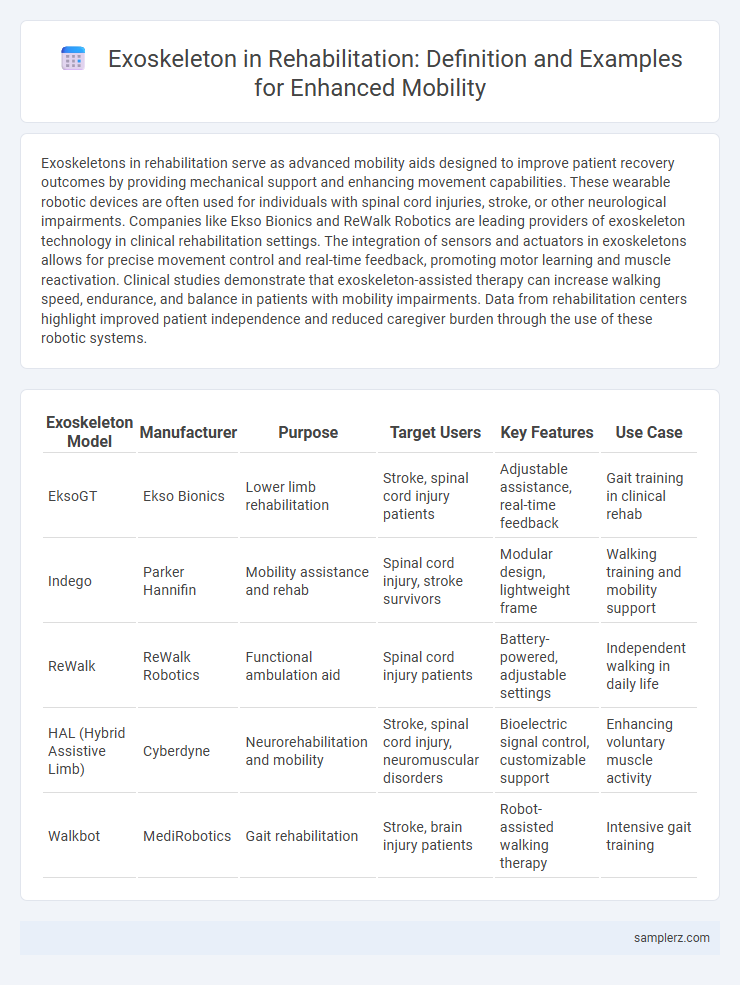Exoskeletons in rehabilitation serve as advanced mobility aids designed to improve patient recovery outcomes by providing mechanical support and enhancing movement capabilities. These wearable robotic devices are often used for individuals with spinal cord injuries, stroke, or other neurological impairments. Companies like Ekso Bionics and ReWalk Robotics are leading providers of exoskeleton technology in clinical rehabilitation settings. The integration of sensors and actuators in exoskeletons allows for precise movement control and real-time feedback, promoting motor learning and muscle reactivation. Clinical studies demonstrate that exoskeleton-assisted therapy can increase walking speed, endurance, and balance in patients with mobility impairments. Data from rehabilitation centers highlight improved patient independence and reduced caregiver burden through the use of these robotic systems.
Table of Comparison
| Exoskeleton Model | Manufacturer | Purpose | Target Users | Key Features | Use Case |
|---|---|---|---|---|---|
| EksoGT | Ekso Bionics | Lower limb rehabilitation | Stroke, spinal cord injury patients | Adjustable assistance, real-time feedback | Gait training in clinical rehab |
| Indego | Parker Hannifin | Mobility assistance and rehab | Spinal cord injury, stroke survivors | Modular design, lightweight frame | Walking training and mobility support |
| ReWalk | ReWalk Robotics | Functional ambulation aid | Spinal cord injury patients | Battery-powered, adjustable settings | Independent walking in daily life |
| HAL (Hybrid Assistive Limb) | Cyberdyne | Neurorehabilitation and mobility | Stroke, spinal cord injury, neuromuscular disorders | Bioelectric signal control, customizable support | Enhancing voluntary muscle activity |
| Walkbot | MediRobotics | Gait rehabilitation | Stroke, brain injury patients | Robot-assisted walking therapy | Intensive gait training |
Introduction to Exoskeletons in Rehabilitation
Exoskeletons in rehabilitation provide advanced mobility assistance by supporting patients with impaired motor functions and enabling repetitive, controlled movements essential for recovery. These wearable robotic devices facilitate gait training and muscle strengthening in individuals recovering from stroke, spinal cord injuries, or neurodegenerative diseases. Clinical studies demonstrate that exoskeleton-assisted therapy improves walking speed, balance, and overall functional independence in rehabilitation settings.
Historical Development of Rehabilitation Exoskeletons
Rehabilitation exoskeletons have evolved significantly since the 1960s, beginning with the rudimentary Hardiman suit developed by General Electric, which laid the foundation for powered assistance in mobility. Advances in robotics and control systems during the 1990s enabled the creation of more compact and responsive devices like the Lokomat, enhancing gait training for stroke and spinal cord injury patients. Modern exoskeletons integrate sensor technologies and adaptive algorithms, improving personalized rehabilitation outcomes and expanding clinical utility worldwide.
Types of Exoskeletons Used in Therapy
Exoskeletons used in rehabilitation therapy are primarily categorized into wearable and stationary types, each designed to enhance mobility for patients with motor impairments. Wearable exoskeletons, such as the ReWalk and EksoGT, support overground walking and improve gait recovery, while stationary exoskeletons like the Lokomat provide robotic-assisted treadmill training for precise lower limb rehabilitation. These devices integrate sensors and actuators to facilitate muscle activation, promote neuroplasticity, and accelerate functional recovery in conditions like stroke, spinal cord injury, and multiple sclerosis.
Lower Limb Exoskeletons for Gait Training
Lower limb exoskeletons, such as the EksoGT and ReWalk systems, are revolutionizing gait training in rehabilitation by providing powered assistance to patients with spinal cord injuries and stroke. These wearable robotic devices enhance muscle activity and promote neuroplasticity, enabling improved walking patterns and increased mobility. Clinical trials demonstrate significant improvements in walking speed, endurance, and balance, accelerating functional recovery and independence.
Upper Limb Exoskeletons for Stroke Recovery
Upper limb exoskeletons play a crucial role in stroke rehabilitation by providing repetitive, controlled movements that enhance motor recovery and neuroplasticity. Devices such as the ArmeoSpring and MyoPro facilitate individualized therapy by supporting arm and hand functions, improving muscle strength and coordination. Clinical studies demonstrate these exoskeletons significantly reduce motor impairments and accelerate functional independence in stroke survivors.
Pediatric Rehabilitation Exoskeleton Applications
Pediatric rehabilitation exoskeletons enhance mobility and support motor function recovery in children with neurological disorders such as cerebral palsy and spinal muscular atrophy. These wearable robotic devices assist gait training by providing adjustable support tailored to pediatric anatomy, promoting muscle strength and neuroplasticity during therapy. Incorporating advanced sensors, pediatric exoskeletons enable real-time feedback and precise movement tracking, improving rehabilitation outcomes and facilitating independent walking.
Robotic Exoskeletons for Spinal Cord Injury
Robotic exoskeletons for spinal cord injury rehabilitation enhance mobility by enabling patients to regain walking ability and improve muscle strength. These devices incorporate advanced sensors and actuators to provide adaptive support and promote neuroplasticity. Clinical studies demonstrate significant improvements in gait, balance, and overall functional independence with consistent exoskeleton-assisted therapy.
Integration of Exoskeletons in Physical Therapy Programs
Exoskeletons integrated within physical therapy programs enhance mobility restoration by providing targeted support and resistance tailored to patient-specific rehabilitation needs. State-of-the-art devices such as the EksoGT and ReWalk facilitate repetitive, controlled movements that promote neuroplasticity and muscle strengthening. Clinical studies indicate that incorporating robotic exoskeletons significantly improves gait recovery and functional independence in patients with spinal cord injuries and stroke.
Patient Outcomes and Benefits of Exoskeleton Rehabilitation
Exoskeleton rehabilitation significantly improves patient outcomes by enhancing mobility, reducing muscle atrophy, and accelerating recovery times following neurological injuries such as stroke or spinal cord injury. Clinical studies demonstrate increased walking speed, endurance, and balance in patients using exoskeleton devices compared to traditional therapy methods. These benefits contribute to greater independence and improved quality of life for individuals undergoing rehabilitative care.
Future Trends in Rehabilitation Exoskeleton Technology
Future trends in rehabilitation exoskeleton technology emphasize advancements in lightweight materials, enhanced sensor integration, and AI-driven adaptive control systems to personalize therapy sessions. Emerging exoskeletons utilize real-time biomechanics data to improve patient mobility and accelerate recovery in stroke and spinal cord injury rehabilitation. Integration with virtual reality environments and telemedicine platforms is set to expand remote rehabilitation capabilities and patient engagement.

example of exoskeleton in rehabilitation Infographic
 samplerz.com
samplerz.com